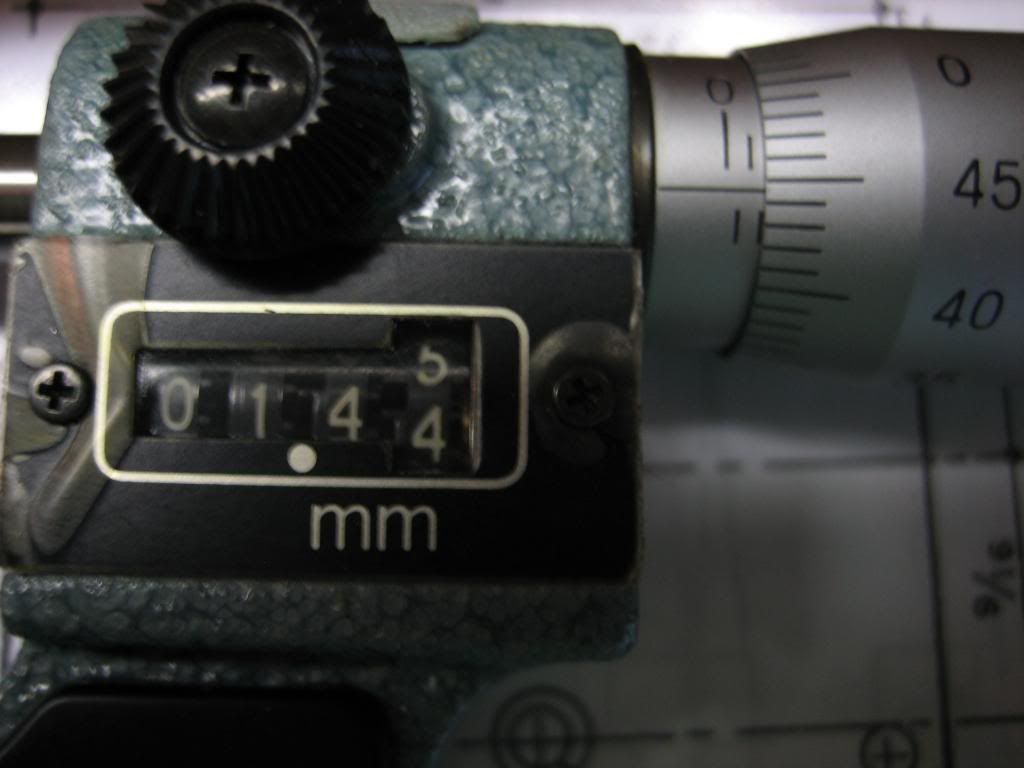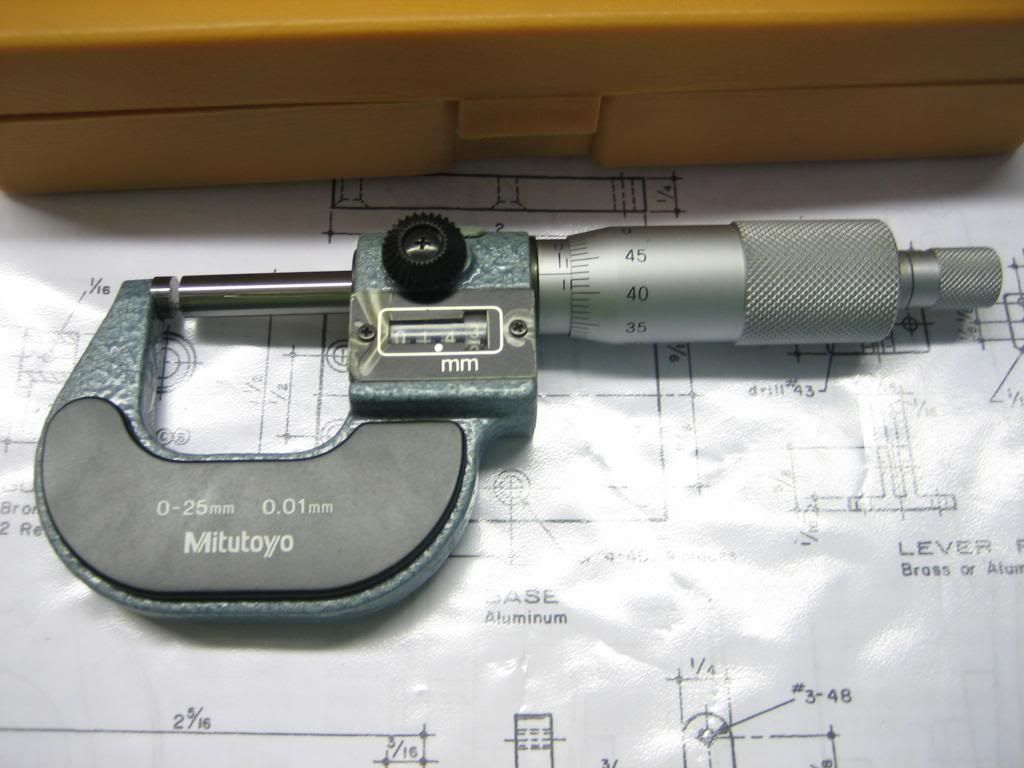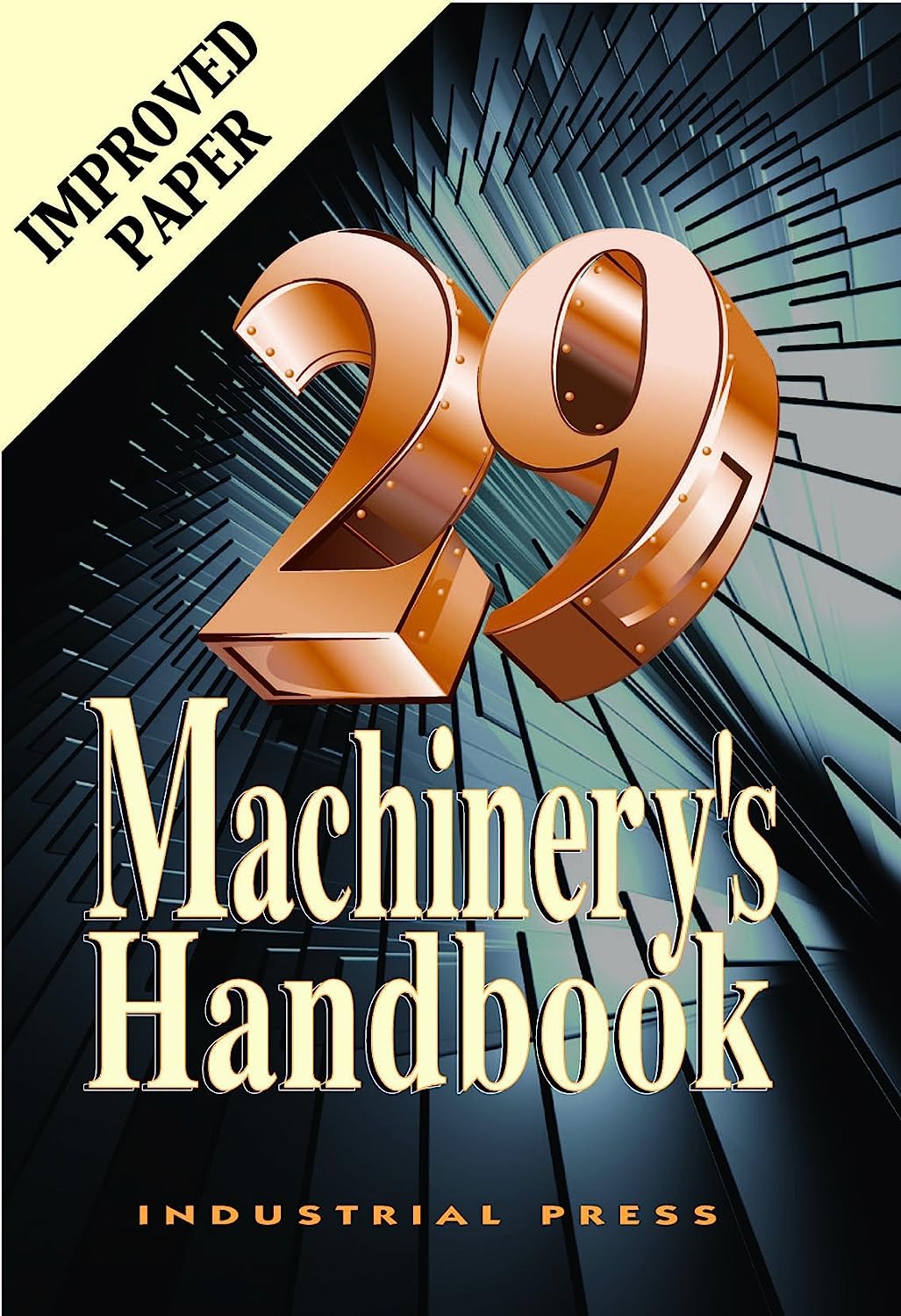You are using an out of date browser. It may not display this or other websites correctly.
You should upgrade or use an alternative browser.
You should upgrade or use an alternative browser.
The beginners tool box
- Thread starter Tin Falcon
- Start date

Help Support Home Model Engine Machinist Forum:
This site may earn a commission from merchant affiliate
links, including eBay, Amazon, and others.
I posted these in hole layout 101 here are a few valuable layout tools
Then drill with a thin drill bit like 1/16 this will follow the punch mark. then with a spot drill . the a pilot drill and finish drill .
Hope this helps.
for bolt circles I like a 6 hole cirlce it so happens that the radius of the circle and the cord distance between holes is the same. Uese the humble diver to lay out.

or you can use the above method to lay out after converting from polar to rectangular coordinates. This can be done with math or consulting the machinery handbook.
Hope this helps
tin
And guys there is still room in the tool box so feel free to add to the box.
Ive heard of this, but how does it work? The formula? thanks Brian
Tin Falcon
Well-Known Member
- Joined
- Jul 9, 2007
- Messages
- 7,207
- Reaction score
- 787
The dividers are one of the most basic tools in geometry navigation and this case layout. Often used along with a straightedge and scribe. this tool can bisect a line or an arc. layout a right triangle (3-4-5 ) rule etc.
as far as laying out a bolt circle it is a matter of scribing the circle then diving into the desired segments. Like said a six hole pattern requires no math as the segment length is equal to the circle radius.
behold that one can use the segment of a circle formula or a published constant table to determine segment length.
and of course trial and error will work but tedius. Just ask in a separate post and I will dig up some more info. Brain a bit tired at the moment.
Tin
as far as laying out a bolt circle it is a matter of scribing the circle then diving into the desired segments. Like said a six hole pattern requires no math as the segment length is equal to the circle radius.
behold that one can use the segment of a circle formula or a published constant table to determine segment length.
and of course trial and error will work but tedius. Just ask in a separate post and I will dig up some more info. Brain a bit tired at the moment.
Tin
I hope I don't offend anyone, but I think we have lost the thread somewhat.
A beginners toolbox only needs the bare basics, everything else is on a 'as needed' basis.
Some means of marking out, 6 and 12 inch rulers, dividers, scriber, engineers square.
Some means to do drilling ( depth of pocket will determine quality)
Drills, here my preference ( as a relative beginner myself) is for a set of number drills. The largest in the set being just under 6mm. Anything above that, buy as needed.
Some means of shaping, a set of files.
Some means of holding work, vice.
Finally some means of venting frustration because you don't have all the tools/gadgets everyone else seems to have, my suggestion a large hammer to berate the part you have just screwed up due to not having the right tools!!!
Oh! Nearly forgot - a good tool catalogue, something to drool over saying to ones self ' I NEED one of those, and that, got to have a set of those etc etc.
When you have done, tot the price up and give yourself a heart attack.
Finally, get your wife/partner to make a new set of extra deep pockets in your trousers, boy are you going to need them.
Have a nice day folks........
A beginners toolbox only needs the bare basics, everything else is on a 'as needed' basis.
Some means of marking out, 6 and 12 inch rulers, dividers, scriber, engineers square.
Some means to do drilling ( depth of pocket will determine quality)
Drills, here my preference ( as a relative beginner myself) is for a set of number drills. The largest in the set being just under 6mm. Anything above that, buy as needed.
Some means of shaping, a set of files.
Some means of holding work, vice.
Finally some means of venting frustration because you don't have all the tools/gadgets everyone else seems to have, my suggestion a large hammer to berate the part you have just screwed up due to not having the right tools!!!
Oh! Nearly forgot - a good tool catalogue, something to drool over saying to ones self ' I NEED one of those, and that, got to have a set of those etc etc.
When you have done, tot the price up and give yourself a heart attack.
Finally, get your wife/partner to make a new set of extra deep pockets in your trousers, boy are you going to need them.
Have a nice day folks........
This is one of the tools I use every day, a mitutoyo micrometer
I know that the digital and mechanical micrometer has already been mentioned earlier on in the thread but this is slightly different. It is very easy to read.
I'm not sure what this type is called but it is very handy and doesn't require batteries
Not sure where the best place to buy them is as this is one of the tools my dad has had in one of his draws for years.


I know that the digital and mechanical micrometer has already been mentioned earlier on in the thread but this is slightly different. It is very easy to read.
I'm not sure what this type is called but it is very handy and doesn't require batteries
Not sure where the best place to buy them is as this is one of the tools my dad has had in one of his draws for years.


purpleknif
Well-Known Member
- Joined
- Aug 9, 2011
- Messages
- 369
- Reaction score
- 38
I would suggest an "Interapid type" indicator like L.M.S #3709. Way more versatile and easier to use than a dovetail style. Or you can spend $180 for an Interapid. Doubt that its that much better but most shops want you to have an Interapid.
I would suggest an "Interapid type" indicator like L.M.S #3709. Way more versatile and easier to use than a dovetail style. Or you can spend $180 for an Interapid. Doubt that its that much better but most shops want you to have an Interapid.
Interapid indicators are pleasure to use, especially on a Bridgeport.
If you have a small lathe, you might prefer an indicator that is physically smaller. I use a second-hand ($20.00 in 1980)Starrett 711 Last Word, on my 6" Craftsman 101.21400, as well as my larger lathe.
Tom
My three beginners essentials not yet mentioned
1 - Hammers - Ball pein 3/4-2lb and also a plastic mallet & a "Thor" copper/rawhide mallet. The Ball pein for centre-dabbing but NOT for hitting precision workpieces or chucks, use the mallets for this. Unfortunately in my workplace there is always a bigger hammer to make pieces fit.
2 - Clamps - both "G" clamps and "Toolmakers" clamps, invaluable for drilling & milling.
3 - A spirit level - a starrett pocket level (2") for setting up workpieces & a 4" magnetic level with adjustable angle positions (great for checking parts in a bandsaw or larger components in a machine
1 - Hammers - Ball pein 3/4-2lb and also a plastic mallet & a "Thor" copper/rawhide mallet. The Ball pein for centre-dabbing but NOT for hitting precision workpieces or chucks, use the mallets for this. Unfortunately in my workplace there is always a bigger hammer to make pieces fit.
2 - Clamps - both "G" clamps and "Toolmakers" clamps, invaluable for drilling & milling.
3 - A spirit level - a starrett pocket level (2") for setting up workpieces & a 4" magnetic level with adjustable angle positions (great for checking parts in a bandsaw or larger components in a machine
- Joined
- May 27, 2010
- Messages
- 2,999
- Reaction score
- 1,171
Hi Guys,
By now, I think the beginner machinist have grown up and to move into the next phase.
By now, I think the beginner machinist have grown up and to move into the next phase.
jeanalvitre
New Member
- Joined
- May 11, 2013
- Messages
- 2
- Reaction score
- 2
Fantastic thread..
Very well documented and very well explained.
thank you..
Very well documented and very well explained.
thank you..
Tin Falcon
Well-Known Member
- Joined
- Jul 9, 2007
- Messages
- 7,207
- Reaction score
- 787
Thank you jean .
Please post an introduction in the welcome are tell us about yourself your shop and your interest in model engine building. And do not worry if english is a second language just do your best.
Tin
Please post an introduction in the welcome are tell us about yourself your shop and your interest in model engine building. And do not worry if english is a second language just do your best.
Tin
DanP
Well-Known Member
"By now, I think the beginner machinist have grown up and to move into the next phase." I think by now, the beginner's tool box has taken over the house.
I have not seen any mention of face shields in this thread.
http://www.mscdirect.com/product/72052558?fromRR=Y
I wear a face shield over my safety glasses for grinding, wire wheeling, and when machining free-cutting metals. Leaded brass, for example, slings tiny chips like crazy.
I wear extra protection when handling hazardous chemicals. Where I worked, our eye protection was safety glasses with side shields, chemical goggles, and a face shield when handling certain chemicals. I check the chemical's Material Safety Data Sheet for the correct personal protective equipment to wear. If in doubt, I call the manufacturer's 800 number.
PITA? Yes. Retiring with two good eyes? Priceless.
Tom
http://www.mscdirect.com/product/72052558?fromRR=Y
I wear a face shield over my safety glasses for grinding, wire wheeling, and when machining free-cutting metals. Leaded brass, for example, slings tiny chips like crazy.
I wear extra protection when handling hazardous chemicals. Where I worked, our eye protection was safety glasses with side shields, chemical goggles, and a face shield when handling certain chemicals. I check the chemical's Material Safety Data Sheet for the correct personal protective equipment to wear. If in doubt, I call the manufacturer's 800 number.
PITA? Yes. Retiring with two good eyes? Priceless.
Tom
robcas631
Well-Known Member
I began the getting started in model engineering thread a long time ago . It has grown and it is well read. I also did a thread on lathe selection . But since I often get the cart before the horse and overlook the obvious I am stating this thread. Please please help with this one .
So here is the concept . we are going to set up machinist tools box suitable for the home shop machinist .
so here are the guidelines : place a tool into this virtual tool box.
(1) Limit one tool per thread . Three tools per person. Something that comes as a set is considered one tool.
(2) This must be a tool you have in your shop and use, like and would recommend to a friend.
(3) Post a photo of the tool. your photo or link to manufacturers or sellers web site. give credit for the photo if not yours.
(4)list price and availabity as much as possible.
(5) explain the tool ,its uses and what you like and limitations. Tell us why you think this is a must have tool for the tool box.
(6) the focus here is filling the virtual tool box but you may post something that does not fit in the box.
(7) I hope this to be a fun and educational experience for all.
Tin
Sometimes I have to view something on my lathe that is in an obscure place. Instead I use a Dental Mirror. It's safer! Most hardware stores carry them. http://www.summitracing.com/parts/wmr-w9103
robcas631
Well-Known Member
This book?


goldstar31
Well-Known Member
Speaking of Dental Mirrors, I have a wife and daughter both of whom are or were dental surgeons. My wife no2 Fellow of the Royal College of Surgeons in Dentistry in Edinburgh and my daughter, like her Mum, a consultant orthodontist.
So I have mirrors but some are placed in different places like the back of a tool and cutter grinder to view progress. It means that one can watch the facet of a tool being ground. Facets on tools become chipped or worn and the crafty system is to leave them on the grinder-after coating the faces with a waterproof ink from a cheap felt pen. Once the minute amount comes offleaves a true face, you are there. However, those wicked probes ( that get into those rotten bits) make invaluable scribers!
Me, with my wife's retirement, I have a pile of junk with assorted accessories that make pliers that will wind springs or hold a bit for soldering or even to cast something rather than a pair of 'gnashers'. Again, there is a set of things to 'improve' my feeble efforts at lost wax casting.
The last contribution came from my daughter who presented my weary eyes -with a pair of surgeons binoculars. She'd won them in some 'free-bie' thing with sales people. They went with a loupe from the author of two books on locomotive gears- because I had saved him a few coins( a lot, really) when his BMW died on my driveway - with acid corrosion in its engine. Now there's a topic not covered here.
Lots not mentioned, eh?
Norman
So I have mirrors but some are placed in different places like the back of a tool and cutter grinder to view progress. It means that one can watch the facet of a tool being ground. Facets on tools become chipped or worn and the crafty system is to leave them on the grinder-after coating the faces with a waterproof ink from a cheap felt pen. Once the minute amount comes offleaves a true face, you are there. However, those wicked probes ( that get into those rotten bits) make invaluable scribers!
Me, with my wife's retirement, I have a pile of junk with assorted accessories that make pliers that will wind springs or hold a bit for soldering or even to cast something rather than a pair of 'gnashers'. Again, there is a set of things to 'improve' my feeble efforts at lost wax casting.
The last contribution came from my daughter who presented my weary eyes -with a pair of surgeons binoculars. She'd won them in some 'free-bie' thing with sales people. They went with a loupe from the author of two books on locomotive gears- because I had saved him a few coins( a lot, really) when his BMW died on my driveway - with acid corrosion in its engine. Now there's a topic not covered here.
Lots not mentioned, eh?
Norman
robcas631
Well-Known Member
Norman
I think you are covered regarding mirrors! My wife found a pair of surgical clamps. They work great for holding peices when soldering!
http://i02.i.aliimg.com/img/pb/880/680/242/1271424311412_hz_fileserver2_248075.jpg
I think you are covered regarding mirrors! My wife found a pair of surgical clamps. They work great for holding peices when soldering!
http://i02.i.aliimg.com/img/pb/880/680/242/1271424311412_hz_fileserver2_248075.jpg
goldstar31
Well-Known Member
Apologies to one and all but I was getting, like the guy on a stretcher- somewhat carried away!
Each hammer has a purpose but I find I use the plastic head the most, followed by the home made brass head with knurled aluminum handle, the ball peen, and rubber mallet. The plastic and brass were both purchased at a local used tool shop called the Tool Shed for $5.00 each. I've got most of my Starrett micrometers there along with a bunch of other machinists tools.
Also not a tool but a tip. If you have a good set of drills there's always sizes in there that you almost never use, I use those to pre-dill a hole then finish with the size needed. Your most used drills will stay sharper longer that way.

Also not a tool but a tip. If you have a good set of drills there's always sizes in there that you almost never use, I use those to pre-dill a hole then finish with the size needed. Your most used drills will stay sharper longer that way.

Similar threads
- Replies
- 0
- Views
- 531
- Replies
- 0
- Views
- 341





